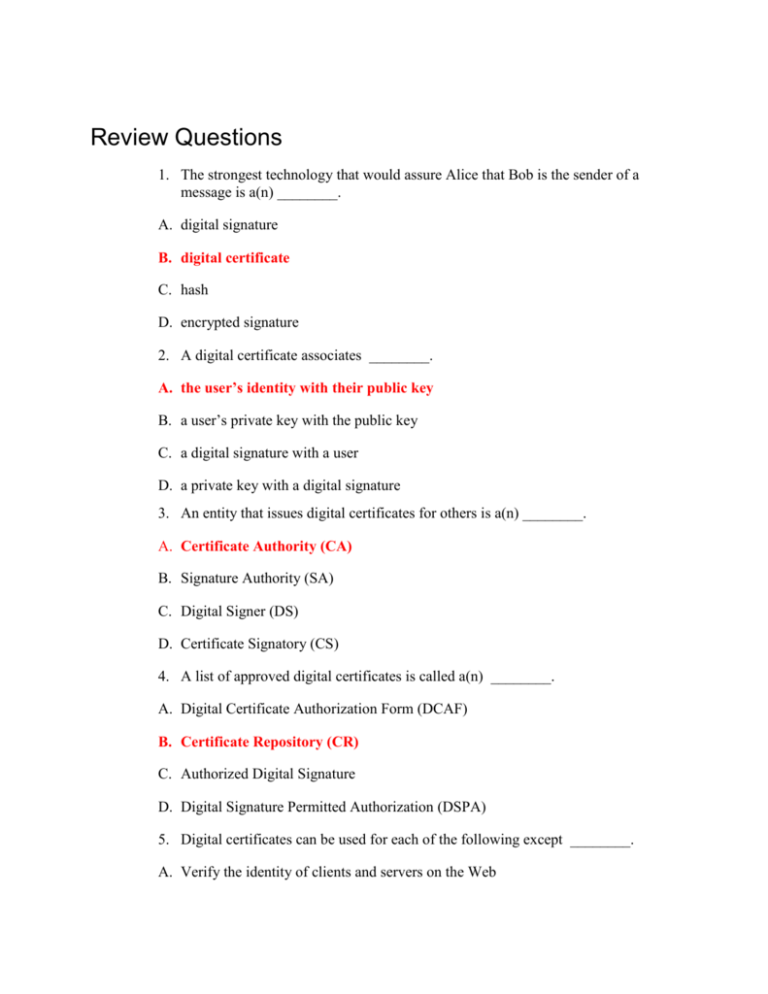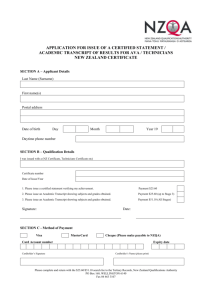Review Questions
advertisement

Review Questions 1. The strongest technology that would assure Alice that Bob is the sender of a message is a(n) ________. A. digital signature B. digital certificate C. hash D. encrypted signature 2. A digital certificate associates ________. A. the user’s identity with their public key B. a user’s private key with the public key C. a digital signature with a user D. a private key with a digital signature 3. An entity that issues digital certificates for others is a(n) ________. A. Certificate Authority (CA) B. Signature Authority (SA) C. Digital Signer (DS) D. Certificate Signatory (CS) 4. A list of approved digital certificates is called a(n) ________. A. Digital Certificate Authorization Form (DCAF) B. Certificate Repository (CR) C. Authorized Digital Signature D. Digital Signature Permitted Authorization (DSPA) 5. Digital certificates can be used for each of the following except ________. A. Verify the identity of clients and servers on the Web B. Encrypt messages for secure e-mail communications C. Verify the authenticity of the Registration Authorizer D. Encrypt channels to provide secure communication between clients and servers 6. In order to ensure a secure cryptographic connection between a Web browser and a Web server a _____ digital certificate would be used. A. personal digital certificate B. Web digital certificate C. personal Web certificate determining the integrity of a message D. server digital certificate 7. A digital certificate that turns the address bar green is a(n) ________. A. Extended Validation SSL Certificate B. Web Server Advanced Certificate C. Personal Web-Client Certificate D. Internet Standard Certificate 8. Digital certificates that are split into two parts are known as _____ certificates. A. binary B. extended C. dual-sided D. split 9. Which of the following is NOT a field of an X.509 certificate? A. validity period B. serial number C. signature D. CA expiration code 10. Public key infrastructure (PKI) ________. A. protects cipherkey cryptography B. generates public/private keys automatically C. is the management of digital certificates D. creates private key cryptography 11. Public-Key Cryptography Standards (PKCS) ________. A. have been replaced by PKI B. are widely accepted in the industry C. define how hashing algorithms are created D. are used to create public keys only 12. The ______ trust model supports CA. A. direct B. indirect C. third party D. remote 13. Hierarchical trust models are best suited for ________. A. Internet usage B. single organizations C. settings with multiple CAs and RAs D. organizations with fewer than 10 users 14. A(n) _____ is a published set of rules that govern the operation of a PKI. A. Certificate Practice Statement (CPS) B. Signature Resource Guide (SRG) C. Enforcement Certificate D. certificate policy (CP) 15. Each of the following is a part of the certificate life cycle except ________. A. Creation B. Revocation C. Authorization D. Expiration 16. Keys can be stored in each of the following except ________. A. embedded in digital certificates B. stored on the user’s local system C. in tokens D. in hashes 17. _____ refers to a situation in which keys are managed by a third-party, such as a trusted CA. A. Key escrow B. Trusted key authority C. Key authorization D. Remote key administration 18. A cryptographic transport protocol for FTP is ________. A. RAS-256 B. MIME C. UNIX Remote Shell Encryption (UNIX-RSE) D. Secure Sockets Layer (SSL) 19. What is the cryptographic transport protocol that is used most often to secure Web transactions? A. HTTPS B. SHTTP C. PPPTPoE D. MD-17 20. Which is the most secure VPN cryptographic transport protocol? A. LPTP2 B. PTP C. IPsec D. Hash-32







